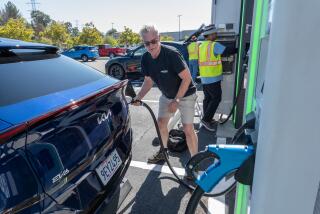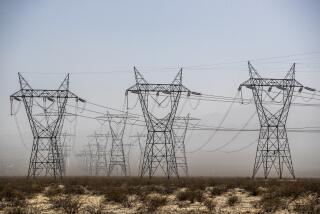Op-Ed: Renewable energy is a California success story
In 2011, Solyndra, a California-based solar panel manufacturer, defaulted on a $535-million federal loan and went bankrupt. Critics argued that this proved renewable energy was hopelessly impractical and expensive and that federal and state policies to support it were a waste of taxpayer money. Americans for Prosperity, a group funded by the Koch brothers, spent $6 million on an ad campaign highlighting the company as a symbol of failure. Even the venerable “60 Minutes” got into the fray, reporting there was a “cleantech crash.” California, in particular, was singled out for ridicule. Pundits warned that strong support for renewable energy would bring down our economy.
But four years later, the real story is that the focus on the demise of a single company obscured the emergence of a thriving industry. Renewable energy has grown so rapidly that, in 2014, it accounted for most new electric generation capacity added nationwide. California leads the pack with the share of electricity from renewable sources, more than doubling from 12% in 2008 to 25% today. In that period, private companies invested more than $20 billion in new renewable power plants here. California is home to the largest geothermal, wind, solar thermal and solar photovoltaic power plants in the world.
All the leading utilities in the state have signed contracts ensuring the state will get more than 33% of its electricity from renewables by 2020. Renewable energy prices have fallen to record lows. Building on that momentum, Gov. Jerry Brown has set a new state goal of 50% renewable energy by 2030. Reaching such a milestone would make fossil fuels the alternative energy. Momentum also exists at the local level. Mayor R. Rex Parris of Lancaster, Calif., made his city the first in the nation to mandate solar power on all new construction.
Meanwhile, the early predictions of California’s economic calamity have proved to be misinformed. Unemployment in the state has fallen from 12% in 2011 to 6.9% today. California’s largest manufacturing operation in terms of employees at a single site is an electric car company, Tesla, whose 8,000 employees turn out 1,000 cars a week (Tesla received a federal loan guarantee roughly the same size as Solyndra’s and repaid it in its entirety nine years early).
As for the Department of Energy’s federal loan guarantee program, it too has proved to be a win for taxpayers. Out of a $34-billion portfolio, only 2.38% of the loans defaulted, and the interest payments from the successful projects have brought in more money than what was lost. Today, the program is $30 million in the black.
The clean energy projects and companies enabled by federal and state policy support are creating new technologies and adding a competitive advantage to the U.S. economy along with new jobs. The U.S. solar industry’s job growth increased 86% in the last five years and employs 174,000 Americans. More than 75,000 Americans work in the wind power industry. In California, more work in the solar energy industry than in all the state’s investor-owned utilities combined.
President Reagan, like many people in both parties at the time, thought renewable energy was a pipe dream and removed the solar panels President Carter had installed on the White House roof. But Reagan’s secretary of State, George Shultz, has noted, “The United States is on the cusp of a true revolution in the field of energy, and if we can capitalize on these opportunities we’ll have a much better energy future from the standpoint of our national defense, from the standpoint of our economy, and from the standpoint of our environment.”
And he’s right. Shultz now drives an electric car and has put solar panels on his house.
If we have learned one thing in the years since Solyndra, it is that, though individual companies can and do fail, it is a bad idea to bet against clean energy innovation. Even as a work in progress, California is demonstrating that the transition to more secure, sustainable forms of energy can also offer a more prosperous future.
California-based SolarCity, the largest solar installer in the world, has been acquiring new space. One of the buildings the firm is moving into is the old Solyndra factory.
David Hochschild is a commissioner at the California Energy Commission, the state’s primary energy policy and planning agency. David Olsen is a member of the board of governors of the California Independent System Operator, which manages the state’s electric grid.
Follow the Opinion section on Twitter @latimesopinion and Facebook
More to Read
A cure for the common opinion
Get thought-provoking perspectives with our weekly newsletter.
You may occasionally receive promotional content from the Los Angeles Times.






